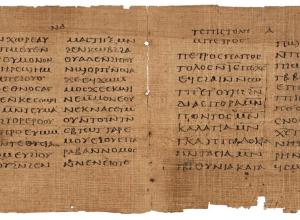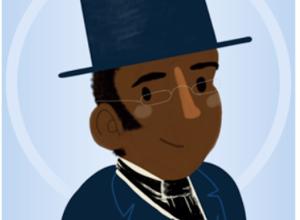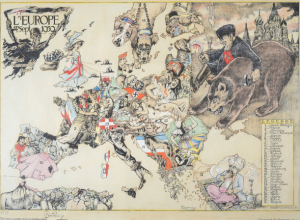University of Dayton to Display Stuart Rose’s Rare Books & Manuscripts This Fall
DAYTON, Ohio—Some of the rarest books in the world will be on display at the University of Dayton this fall, from authors like Austen, Chaucer, Copernicus, Marie Curie, Shakespeare and Mark Twain.
"Imprints and Impressions: Milestones in Human Progress" will feature first editions, manuscripts, galley proofs, papyri and illustrations spanning the scholarly spectrum from philosophy to physics. The free, public exhibit runs Sept. 29 through Nov. 9 in the Roesch Library first-floor gallery on the University of Dayton campus.
The books and manuscripts are on loan from Stuart Rose, a Dayton-area businessman who has assembled one of the most accomplished collections of its kind in private hands, said rare book expert Nicholas Basbanes, author of several books, including A Gentle Madness, about book lovers and the lengths collectors go to find their treasures.
Basbanes said "Imprints and Impressions" is a rare opportunity to glimpse manuscripts and early editions that are often kept out of public view in private collections or locked in rooms at libraries.
"I don't recall an exhibition quite like this in recent memory, certainly not one as comprehensive in scope as this, and with all the material coming from one private collection," Basbanes said. "Stuart Rose has collected grandly, and in many areas. Most collectors of any consequence aspire to have at least one great book on their shelves. He has dozens, and there is nothing that is trivial or insignificant."
Basbanes will kick off the exhibit with a lecture at 7:30 p.m. Monday, Sept. 29, in the Kennedy Union ballroom, followed by the public opening of the exhibit in Roesch Library. His address is one of more than 18 events around the exhibit expanding on co-curricular learning through talks, workshops and performances, with many open to the public.
The exhibit and surrounding events fit in perfectly with the University's broader curriculum goals, said Kathleen Webb, dean of University Libraries. She said Rose's collection reflects a range of academic disciplines and is illustrative of the University of Dayton's approach to undergraduate education.
"We wanted a selection of titles that would interest faculty and provide an opportunity for interdisciplinary conversation, and that also would challenge students to link aspects of their own lives, majors and careers to a broader world. I think we have succeeded," Webb said. "The books and authors in this exhibit are quite literally a representation of the learning outcomes for our Common Academic Program: scholarship, practical wisdom, faith, community, diversity, evaluation of our times, and vocation."
Rose began collecting in 1992 with a first-edition Tarzan by Edgar Rice Burroughs, followed shortly by books from Mark Twain and Charles Dickens and a Shakespeare First Folio. He's been filling in the gaps ever since.
"I set out for maybe 50 great books, but once you get started, you start learning, and so I just kept going," Rose said. "I've focused on first editions of important books that have changed or entertained the world. And with each book, I learn something new. I hope my collection inspires others to realize that learning is a lifelong pursuit and to pursue their interests."
He now has more than 2,000 books, loosely organized but beautifully displayed on wooden shelves and in glass cases in two small rooms of his house.
Earlier this year, he gladly accepted an invitation to loan a portion of his collection to the University of Dayton, and faculty selected 49 books that represent a variety of disciplines.
"A great, old book, to me, is like a great painting," Rose said. "It should be on display. It's one thing to look at a picture of something old, but it's another thing seeing it in person. It's just a different feeling."
Basbanes couldn't agree more. As he looked over the exhibit listing, he read off titles he was eager to view:
- Phillis Wheatley, the first published African-American poet: "She had to go before a committee to prove that she actually wrote it."
- Huckleberry Finn: "With a double signature of Samuel Clemens and Mark Twain."
- "Look at what he has from women." Mary Wollstonecraft, Virginia Woolf, Anne Frank and Marie Curie, Jane Austen, Wheatley and Maria Montessori.
- Chaucer, a Shakespeare Folio, Galileo. "Just one of two known copies of the first edition."
- Copernicus, first edition. "One of the rarest books in the world, and worth visiting the exhibit for that alone."
Basbanes said the collection also is remarkable for its inclusion of several books known as "incunabula"—a Latin term loosely translated as meaning "from the cradle," and identifying books produced during the infancy years of printing in the West, from about 1450, when Johan Gutenberg introduced printing from moveable metal type, to 1501.
"This collection is full of benchmarks in the annals of Western civilization. They aren't just books, they're artifacts. You're looking at books that have been instrumental in changing the way people think and how they live. There is a materiality to this that is palpable; they bring you as close as you are likely to get to physically touching the creative process."
The exhibit is not just for viewing—it will be significantly integrated into the first-year curriculum, with all incoming students reading at least one of the books represented in the exhibit. Faculty are also assisting with the online exhibit and collaborating to offer co-curricular programs.
The University is sponsoring a catalogue of the exhibit, to include essays from three faculty in psychology, religious studies and chemistry. Students in a web design class also created a preview site for the exhibit.
For more information on the exhibit, including a book listing and a calendar of related events, visit http://go.udayton.edu/rarebooks.















